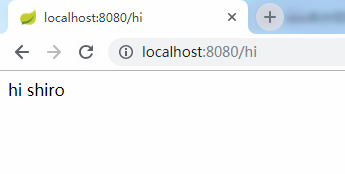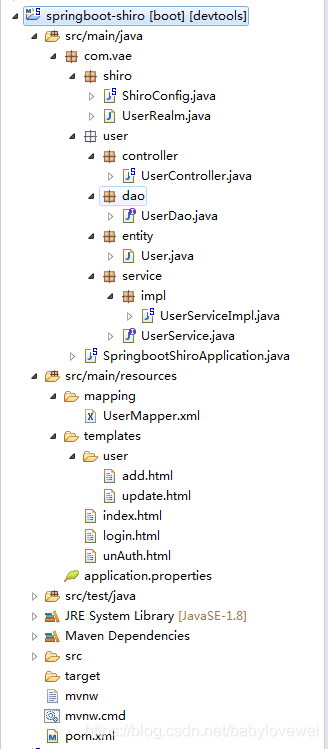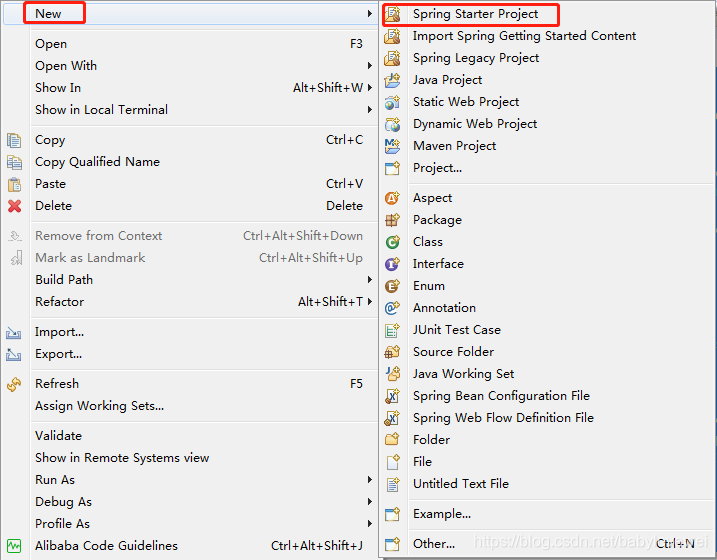一、搭建SpringBoot开发环境
1. 安装好开发软件和Maven等
开发工具:Spring Tool Suite(TST)
Maven :3.3.9
jdk:1.8
2. 创建springboot项目(此功能需要联网)

3. pom.xml文件配置
<?xml version="1.0" encoding="UTF-8"?>
<project xmlns="http://maven.apache.org/POM/4.0.0" xmlns:xsi="http://www.w3.org/2001/XMLSchema-instance"
xsi:schemaLocation="http://maven.apache.org/POM/4.0.0 http://maven.apache.org/xsd/maven-4.0.0.xsd">
<modelVersion>4.0.0</modelVersion>
<parent>
<groupId>org.springframework.boot</groupId>
<artifactId>spring-boot-starter-parent</artifactId>
<version>2.1.3.RELEASE</version>
<relativePath/> <!-- lookup parent from repository -->
</parent>
<groupId>com.vae</groupId>
<artifactId>shiro</artifactId>
<version>0.0.1-SNAPSHOT</version>
<name>springboot-shiro</name>
<description>Demo project for Spring Boot</description>
<properties>
<project.build.sourceEncoding>UTF-8</project.build.sourceEncoding>
<project.reporting.outputEncoding>UTF-8</project.reporting.outputEncoding>
<java.version>1.8</java.version>
</properties>
<dependencies>
<!-- thymeleaf依赖 -->
<dependency>
<groupId>org.springframework.boot</groupId>
<artifactId>spring-boot-starter-thymeleaf</artifactId>
</dependency>
<!-- Web支持:Spring web开发支持,servlet相关程序等 -->
<dependency>
<groupId>org.springframework.boot</groupId>
<artifactId>spring-boot-starter-web</artifactId>
</dependency>
<dependency>
<groupId>org.springframework.boot</groupId>
<artifactId>spring-boot-starter</artifactId>
</dependency>
<dependency>
<groupId>org.springframework.boot</groupId>
<artifactId>spring-boot-starter-test</artifactId>
<scope>test</scope>
</dependency>
</dependencies>
<build>
<plugins>
<plugin>
<groupId>org.springframework.boot</groupId>
<artifactId>spring-boot-maven-plugin</artifactId>
</plugin>
</plugins>
</build>
</project>
4. 编写测试Controller层
package com.vae.user.controller;
import org.springframework.web.bind.annotation.RequestMapping;
import org.springframework.web.bind.annotation.RestController;
@Controller
public class UserController {
@RequestMapping("/hi")
public String hi(){
return "hi shiro";
}
}5. 启动spring boot启动类
package com.vae;
import org.springframework.boot.SpringApplication;
import org.springframework.boot.autoconfigure.SpringBootApplication;
/**
* springboot启动类
* @author vae
*
*/
@SpringBootApplication
public class SpringbootShiroApplication {
public static void main(String[] args) {
SpringApplication.run(SpringbootShiroApplication.class, args);
}
}
6. 浏览器访问http://localhost:8080/hi 测试

二、使用Thymeleaf页面模板
1. pom.xml 文件中添加 thymeleaf依赖
<!-- thymeleaf依赖 -->
<dependency>
<groupId>org.springframework.boot</groupId>
<artifactId>spring-boot-starter-thymeleaf</artifactId>
</dependency>2. 在UserController中编写测试thymeleaf的方法
下面写了两种方式,第一种比较直观和优雅,第二种相对普遍且代码较少,且迎合从struts2
/**
* 方式一:返回ModelAndView
*/
@RequestMapping("/index")
public ModelAndView index() {
ModelAndView view = new ModelAndView();
// 设置跳转的视图 默认映射到 src/main/resources/templates/{viewName}.html
view.setViewName("index");
// 设置属性
view.addObject("title", "我的templates页面");
view.addObject("desc", "欢迎进入我的csdn博客");
Author author = new Author();
author.setAge(18);
author.setEmail("xhw_vae@163.com");
author.setName("way");
view.addObject("author", author);
return view;
}
/**
* 方式二:返回String
* 注意:此方式不可以使用@RestController,@RestController 等价
* 于 @Controller 加上 @ResponseBody,@ResponseBody表示
* 该方法的返回不会被解析为跳转, 而是直接写入http响应正文。
*/
@RequestMapping("/index1")
public String index1(HttpServletRequest request) {
// TODO 与上面的写法不同,但是结果一致。
// 设置属性
request.setAttribute("title", "我的templates页面");
request.setAttribute("desc", "欢迎进入我的csdn博客");
Author author = new Author();
author.setAge(18);
author.setEmail("xhw_vae@163.com");
author.setName("way");
request.setAttribute("author", author);
// 返回的 index 则会映射到 src/main/resources/templates/index.html
return "index";
}
class Author {
private int age;
private String name;
private String email;
// 省略 get set
}3. 在resources/templates文件夹下新建index.html模板文件
可以看到 thymeleaf 是通过在标签中添加额外属性动态绑定数据的
<!DOCTYPE html>
<html xmlns="http://www.w3.org/1999/xhtml"
xmlns:th="http://www.thymeleaf.org">
<head>
<meta charset="UTF-8">
<!-- 可以看到 thymeleaf 是通过在标签里添加额外属性来绑定动态数据的 -->
<title th:text="${title}">Title</title>
<!-- 在/resources/static/js目录下创建一个hello.js 用如下语法依赖即可-->
<script type="text/javascript" th:src="@{/js/hello.js}"></script>
</head>
<body>
<h1 th:text="${desc}">Hello World</h1>
<h2>=====作者信息=====</h2>
<p th:text="${author?.name}"></p>
<p th:text="${author?.age}"></p>
<p th:text="${author?.email}"></p>
</body>
</html>4. 浏览器访问http://localhost:8080/index测试

三、shiro认证-ShiroConfig配置类
1. shiro的核心API
Subject:用户主体(关联SecurityManager,把操作交给SecurityManager)
SecurityManager:安全管理器(关联Realm)
Realm:shiro连接数据库的桥梁
2. Spring整合shiro
(1)添加shiro和spring整合依赖
<!-- shiro和spring整合依赖 -->
<dependency>
<groupId>org.apache.shiro</groupId>
<artifactId>shiro-spring</artifactId>
<version>1.4.0</version>
</dependency>(2)自定义Realm类
package com.vae.shiro;
import org.apache.shiro.authc.AuthenticationException;
import org.apache.shiro.authc.AuthenticationInfo;
import org.apache.shiro.authc.AuthenticationToken;
import org.apache.shiro.authz.AuthorizationInfo;
import org.apache.shiro.realm.AuthorizingRealm;
import org.apache.shiro.subject.PrincipalCollection;
public class UserRealm extends AuthorizingRealm{
/**
* 授权逻辑
*/
@Override
protected AuthorizationInfo doGetAuthorizationInfo(PrincipalCollection arg0) {
System.out.println("执行授权逻辑");
return null;
}
/**
* 认证逻辑
*/
@Override
protected AuthenticationInfo doGetAuthenticationInfo(AuthenticationToken arg0) throws AuthenticationException {
System.out.println("执行认证逻辑");
return null;
}
}(3)编写shiro配置类(基本结构)
package com.vae.shiro;
import org.apache.shiro.spring.web.ShiroFilterFactoryBean;
import org.apache.shiro.web.mgt.DefaultWebSecurityManager;
import org.springframework.beans.factory.annotation.Qualifier;
import org.springframework.context.annotation.Bean;
import org.springframework.context.annotation.Configuration;
/**
* shiro的配置类
* @author Administrator
*
*/
@Configuration
public class ShiroConfig {
/**
* 创建ShiroFilterFactoryBean
*/
@Bean
public ShiroFilterFactoryBean getShiroFilterFactoryBean(@Qualifier("securityManager")DefaultWebSecurityManager securityManager) {
ShiroFilterFactoryBean shiroFilterFactoryBean =new ShiroFilterFactoryBean();
// 设置安全管理器
shiroFilterFactoryBean.setSecurityManager(securityManager);
return shiroFilterFactoryBean;
}
/**
* 创建DefaultWebSecurityManager
*/
@Bean(name="securityManager")
public DefaultWebSecurityManager getdefaultDefaultWebSecurityManager(@Qualifier("userRealm")UserRealm userRealm){
DefaultWebSecurityManager securityManager=new DefaultWebSecurityManager();
//关联Realm
securityManager.setRealm(userRealm);
return securityManager;
}
/**
* 创建Realm
*/
@Bean(name="userRealm")
public UserRealm getRealm(){
return new UserRealm();
}
}
四、shiro认证-使用shiro过滤器实现认证资源拦截
1. 在templates下新建user/add.html和user/update.html
/user/add.html
<!DOCTYPE html>
<html>
<head>
<meta charset="UTF-8">
<title>用户新增页面</title>
</head>
<body>
<h1>用户新增页面</h1>
</body>
</html>/user/update.html
<!DOCTYPE html>
<html>
<head>
<meta charset="UTF-8">
<title>用户修改页面</title>
</head>
<body>
<h1>用户修改页面</h1>
</body>
</html>
2. 在UserController中编写访问这两个页面的方法
@RequestMapping("/add")
public String add() {
return "user/add";
}
@RequestMapping("/update")
public String update() {
return "user/update";
}3. 在index.html页面中添加这两个页面的超链接
进入用户新增页面:<a href="add">用户新增</a>
进入用户更新页面:<a href="update">用户更新</a>重启测试http://localhost:8080/index可访问。

4. 修改ShiroConfig类的getShiroFilterFactoryBean方法中添加拦截
@Bean
public ShiroFilterFactoryBean getShiroFilterFactoryBean(@Qualifier("securityManager")DefaultWebSecurityManager securityManager) {
ShiroFilterFactoryBean shiroFilterFactoryBean =new ShiroFilterFactoryBean();
//设置安全管理器
shiroFilterFactoryBean.setSecurityManager(securityManager);
/*
* 添加shiro内置过滤器,实现权限相关的url拦截
* 常见过滤器:
* anon:无需认证(登录)可以访问
* authc:必须认证才可以访问
* user:如果使用Remember Me的功能,可以直接访问
* perms:该资源必须得到资源权限才可以访问
* role:该资源必须得到角色权限才可以访问
*/
Map<String, String> filterMap = new LinkedHashMap<>();
filterMap.put("/add", "authc");
filterMap.put("/update", "authc");
shiroFilterFactoryBean.setFilterChainDefinitionMap(filterMap);
return shiroFilterFactoryBean;
}拦截之后重启,再次访问发现:试图访问add或者update,会自动跳转到login.jsp页面 ,此时没有login.jsp所以会出现404的错误,继续操作后面步骤
| Filter | 解释 |
|---|---|
| anon | 无参,开放权限,可以理解为匿名用户或游客 |
| authc | 无参,需要认证 |
| logout | 无参,注销,执行后会直接跳转到shiroFilterFactoryBean.setLoginUrl(); 设置的 url |
| authcBasic | 无参,表示 httpBasic 认证 |
| user | 无参,表示必须存在用户,当登入操作时不做检查 |
| ssl | 无参,表示安全的URL请求,协议为 https |
| perms[user] | 参数可写多个,表示需要某个或某些权限才能通过,多个参数时写 perms[“user, admin”],当有多个参数时必须每个参数都通过才算通过 |
| roles[admin] | 参数可写多个,表示是某个或某些角色才能通过,多个参数时写 roles[“admin,user”],当有多个参数时必须每个参数都通过才算通过 |
| rest[user] | 根据请求的方法,相当于 perms[user:method],其中 method 为 post,get,delete 等 |
| port[8081] | 当请求的URL端口不是8081时,跳转到schemal://serverName:8081?queryString 其中 schmal 是协议 http 或 https 等等,serverName 是你访问的 Host,8081 是 Port 端口,queryString 是你访问的 URL 里的 ? 后面的参数 |
5. 修改拦截后跳转的页面
(1)在templates下新增login.html页面
(2)在ShiroConfig中shiroFilterFactoryBean方法中修改拦截后跳转的页面
//修改跳转的登录页面,不加此项就会跳转到login.jsp页面
shiroFilterFactoryBean.setLoginUrl("/toLogin");(3)在UserController中添加toLogin方法
@RequestMapping("/toLogin")
public String toLogin() {
return "login";
}测试,当没有权限跳转到该login.html页面
6. 用通配符拦截
filterMap.put("/index", "anon");
filterMap.put("/*", "authc");五、shiro认证-实现用户登录功能
1. 修改完善之前的login.html页面
<!DOCTYPE html>
<html>
<head>
<meta charset="UTF-8">
<title>登录页面</title>
</head>
<body>
<h1>登录页面</h1>
<span style="color:red" th:text="${msg}"></span>
<form method="post" action="login">
<input type="text" name="username" /><br>
<input type="password" name="password"><br>
<input type="submit" name="submit" value="登录">
</form>
</body>
</html>2. 在UserController中编写/login请求,编写登录的处理逻辑
@RequestMapping("/login")
public String login(String username, String password, Model model) {
//使用shiro编写认证操作
//获取Subject
Subject subject = SecurityUtils.getSubject();
//封装用户数据
UsernamePasswordToken token = new UsernamePasswordToken(username, password);
//执行登录方法
try {
//只要执行login方法,就会去执行UserRealm中的认证逻辑
subject.login(token);
//如果没有异常,代表登录成功
//跳转到textThymeleaf页面,代表主页
return "redirect:/index";
} catch (UnknownAccountException e) {
logger.info(username + "用户名不存在");
//登录失败
model.addAttribute("msg", "用户名不存在");
return "login";
} catch (IncorrectCredentialsException e) {
logger.info(username + "密码错误");
model.addAttribute("msg", "密码错误");
return "login";
}
}测试发现,并没有进入/login请求,是因为之前写的拦截器(/*)拦截了所有请求,再对/login请求放行,加入代码:
filterMap.put("/login", "anon");
重启测试,发现执行了认证逻辑,返回了用户名不存在异常。
3. 在UserRealm中编写shiro认证逻辑
/**
* 认证逻辑
*/
@Override
protected AuthenticationInfo doGetAuthenticationInfo(AuthenticationToken arg0) throws AuthenticationException {
System.out.println("执行认证逻辑");
//先写模拟数据进行验证,下一步再连接数据库,假设数据库的用户名和密码如下
String dbusername = "vae";
String dbpassword = "123456";
//编写shiro判断逻辑,判断用户名和密码
//1. 判断用户名
UsernamePasswordToken token = (UsernamePasswordToken) arg0;
if (!token.getUsername().equals(dbusername)) {
//用户名不存在shiro底层会抛出UnknownAccountException
return null;
}
//2. 判断密码,参数1:需要返回给login方法的数据;参数2:数据库密码,shiro会自动判断
return new SimpleAuthenticationInfo("", dbpassword, "");
}
4. 启动程序,进行测试
六、shiro认证-整合MyBatis完善用户登录

1. 导入Mybatis相关的依赖
<!-- druid德鲁伊连接池 -->
<dependency>
<groupId>com.alibaba</groupId>
<artifactId>druid</artifactId>
<version>1.1.10</version>
</dependency>
<!-- mysql -->
<dependency>
<groupId>mysql</groupId>
<artifactId>mysql-connector-java</artifactId>
</dependency>
<!-- Spring的MyBatis启动器 -->
<dependency>
<groupId>org.mybatis.spring.boot</groupId>
<artifactId>mybatis-spring-boot-starter</artifactId>
<version>1.1.1</version>
</dependency>
2. 配置application.properties(src/main/resources下)
(1)创建数据库及用户表
CREATE DATABASE `shiro-demo` CHARACTER SET 'utf8mb4' COLLATE 'utf8mb4_general_ci'
CREATE TABLE `user` (
`id` int(11) NOT NULL AUTO_INCREMENT COMMENT '主键id',
`username` varchar(36) NOT NULL DEFAULT '' COMMENT '用户名',
`password` varchar(36) NOT NULL DEFAULT '' COMMENT '密码',
PRIMARY KEY (`id`)
) ENGINE=InnoDB DEFAULT CHARSET=utf8mb4 COMMENT='用户表';
(2)配置application.properties
spring.datasource.driverClassName=com.mysql.jdbc.Driver
spring.datasource.url=jdbc:mysql://localhost:3306/shiro-demo?characterEncoding=UTF-8&useSSL=false&serverTimezone=UTC
spring.datasource.username=root
spring.datasource.password=root
# 连接池配置
spring.datasource.type=com.alibaba.druid.pool.DruidDataSource
#mybatis mapper扫描位置
mybatis.mapper-locations=mapper/*.xml
3. 编写User实体类
package com.vae.user.entity;
public class User {
private Integer id;
private String username;
private String password;
//省略get和set方法
}4. 编写接口UserDao.java
package com.vae.user.dao;
import com.vae.user.entity.User;
public interface UserDao {
/**
* 根据username查找用户信息
* @param username
* @return
*/
User findByUsername(String username);
}
5. 编写UserMapper.xml映射文件
<?xml version="1.0" encoding="UTF-8"?>
<!DOCTYPE mapper PUBLIC "-//mybatis.org//DTD Mapper 3.0//EN" "http://mybatis.org/dtd/mybatis-3-mapper.dtd">
<!-- 此处指向dao接口 -->
<mapper namespace="com.vae.shiro.user.dao.UserDao">
<!-- 此处指向实体类 -->
<resultMap id="BaseResultMap" type="com.vae.shiro.user.entity.User">
<id column="id" jdbcType="INTEGER" property="id" />
<result column="username" jdbcType="VARCHAR" property="username" />
<result column="password" jdbcType="VARCHAR" property="password" />
</resultMap>
<sql id="Base_Column_List">
id, username, password
</sql>
<!-- 根据username查找用户信息 -->
<select id="findByUsername" parameterType="java.lang.String" resultMap="BaseResultMap">
select
<include refid="Base_Column_List" />
from user
where username= #{username,jdbcType=VARCHAR}
</select>
</mapper>6. 编写UserService.java业务接口
package com.vae.user.service;
import com.vae.user.entity.User;
public interface UserService {
/**
* 根据username查找用户信息
* @param username
* @return
*/
User findByUsername(String username);
}
7. 编写UserServiceImpl.java业务实现类
package com.vae.user.service.impl;
import org.springframework.beans.factory.annotation.Autowired;
import org.springframework.stereotype.Service;
import com.vae.user.dao.UserDao;
import com.vae.user.entity.User;
import com.vae.user.service.UserService;
@Service
public class UserServiceImpl implements UserService{
@Autowired
private UserDao userDao;
@Override
public User findByUsername(String username) {
return userDao.findByUsername(username);
}
}
8. 在Application启动类添加@MapperScan注解,开启Mybatis的Mapper接口扫描
@MapperScan("com.vae.user.dao")9. 修改UserRealm.java,调用刚编写的业务
@Autowired
private UserService userService;
/**
* 执行认证逻辑
*/
@Override
protected AuthenticationInfo doGetAuthenticationInfo(AuthenticationToken arg0) throws AuthenticationException {
System.out.println("执行认证逻辑");
// 编写shiro判断逻辑,判断用户名和密码
System.out.println(arg0.toString());
// 1. 判断用户名
UsernamePasswordToken token = (UsernamePasswordToken) arg0;
User user = userService.findByUsername(token.getUsername());
if (user==null) {
//用户名不存在
return null;//shiro底层会抛出UnknownAccountException
}
// 2. 判断密码
// 参数1:需要返回给login方法的数据;参数2:数据库密码,shiro会自动判断
return new SimpleAuthenticationInfo("", user.getPassword(), "");
}10. 测试

效果相同。
七、Shiro授权-使用Shiro过滤器实现授权页面拦截
1. 在ShiroConfig中添加过滤器
//授权过滤器:授权拦截后,shiro会自动跳转到未授权页面
filterMap.put("/add", "perms[user:add]");
filterMap.put("/*", "authc");Tips:注意要写在/*之前,否则不会拦截
2. 添加设置未授权页面
(1)ShiroConfig中
//修改自动跳转的未授权页面
shiroFilterFactoryBean.setUnauthorizedUrl("/unAuth");(2)UserController中
@RequestMapping("/unAuth")
public String unAuth() {
return "unAuth";
}(3)添加unAuth.html
<!DOCTYPE html>
<html xmlns="http://www.w3.org/1999/xhtml"
xmlns:th="http://www.thymeleaf.org">
<head>
<meta charset="UTF-8">
<title>未授权页面</title>
</head>
<body>
<h1>抱歉!您无权限访问!</h1>
</body>
</html>3. 访问 http://localhost:8080/add 测试

登录认证之后,访问/add页面会提示未授权,而/update可以正常访问。
八、Shiro授权-编写资源授权逻辑
刚才打印的log日志中可以看到,只要访问了需要授权访问的资源,就会执行UserRealm中的doGetAuthenticationInfo()方法,在该方法中给资源进行授权。
/**
* 执行授权逻辑
*/
@Override
protected AuthorizationInfo doGetAuthorizationInfo(PrincipalCollection arg0) {
System.out.println("执行授权逻辑");
//给资源进行授权
SimpleAuthorizationInfo info=new SimpleAuthorizationInfo();
//添加资源的授权字符串
info.addStringPermission("user:add");
return info;
}
测试查看效果:日志中可以看到执行了该授权逻辑,现在可以访问/add了
九、Shiro授权-关联数据库动态授权
1. 修改数据表
给user表添加perms字段,插入两个测试用户

2. 一系列小修改
(1)User.java:添加perms属性和getter/setter
(2)UserDao.java:
public User findById(Integer id);(3)UserMapper.xml
<!-- 根据id查找用户信息 -->
<select id="findById" parameterType="java.lang.Integer" resultMap="BaseResultMap">
select
<include refid="Base_Column_List" />
from user
where id = #{id,jdbcType=INTEGER}
</select>(4)UserService.java
public User findById(Integer id);(5)UserServiceImpl.java
@Override
public User findById(Integer id) {
return userMapper.findById(id);
}(6)给/update添加资源拦截
filterMap.put("/update", "perms[user:update]");3. 修改UserRealm中的doGetAuthorizationInfo方法
@Override
protected AuthorizationInfo doGetAuthorizationInfo(PrincipalCollection arg0) {
System.out.println("执行授权逻辑");
//给资源进行授权
SimpleAuthorizationInfo info=new SimpleAuthorizationInfo();
/*//添加资源的授权字符串
info.addStringPermission("user:add");*/
//获取当前用户
Subject subject=SecurityUtils.getSubject();
User user=(User)subject.getPrincipal();
//到数据库查询当前登录用户的授权字符串
User dbUser=userService.findById(user.getId());//通过当前登录用户id查找的数据库用户
info.addStringPermission(dbUser.getPerms());
return info;
}将doGetAuthenticationInfo()方法的返回修改为
return new SimpleAuthenticationInfo(user,user.getPassword(),"");
因为User user=(User)subject.getPrincipal(); 所取得的当前登录用户就是从这里来的
4. 登录不同权限用户进行测试
各自有了各自的权限。
十、ThymeLeaf和shiro标签整合使用
1. 导入thymeleaf对shiro的扩展坐标
<!-- 导入thymeleaf对shiro的扩展坐标 -->
<dependency>
<groupId>com.github.theborakompanioni</groupId>
<artifactId>thymeleaf-extras-shiro</artifactId>
<version>2.0.0</version>
</dependency>2. 配置ShiroDialect
ShiroConfig中
@Bean
public ShiroDialect getShiroDialect(){
return new ShiroDialect();
}3. 在页面上使用shiro标签
<div shiro:hasPermission="user:add">
进入用户新增页面:<a href="add">用户新增</a>
</div>
<div shiro:hasPermission="user:update">
进入用户更新页面:<a href="update">用户更新</a>
</div>
4. 运行测试
不同权限用户登录,只显示了他有权限看到的内容。

十一.项目完整目录


